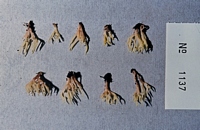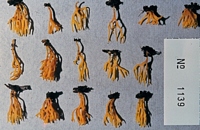|
 Ramariopsis bicolor Ramariopsis bicolor
BiostatusPresent in region - Indigenous. Endemic
Images (click to enlarge)
Caption: 1137, id. R. Petersen, label 50x10mm, NZ, NI, Waipoua, Yakas Tree Track, on rotten wood-bark of wood, 24.06.1981, leg. EH
Owner: E. Horak | 
Caption: 1139, id. R. Petersen, label 50x10mm, NZ, NI, Waipoua, Yakas Tree Track, on rotten wood-bark of
Metrosideros sp., 24.06.1981, leg. EH
Owner: E. Horak |
Article: Petersen, R.H. (1988). The clavarioid fungi of New Zealand. New Zealand Department of Scientific and Industrial Research, Bulletin 236: 170 pp. Wellington:.
Description: Fruit bodies up to 2.5 x.1 cm, slender, delicate, branched, arbuscular, arising from very small whitish mycelial patches. Stipe up to 17 x 1.5 mm, clear golden yellow ('light orange-yellow") when young, slowly hysterochroic to fleshy tan ("light ochraceous salmon", "ochraceous salmon"), cinnamon or rich cinnamon ("vinaceous cinnamon", "vinaceous rufous") from the base upward, eventually overtaking the branches so that in mature fruit bodies only the apices remain yellow. Branches concolourous with stipe, finally hysterochroic, in 2-3 ranks, less than 1 mm thick; axils rounded; intemodes diminishing gradually. Apices clear yellow ("maize-yellow", "baryta-yellow"). Taste and odour negligible.
Macrochemical reaction: FCL on hymenium obscurely purplish slate.
Tramal hyphae of branches hyaline, turning darkin mass in 2% KOH, conspicuously clamped, hardly inflated, thin- to thick-walled (wall up to 0.4 gm thick, refringent), parallel, sinuous. Subhymenium of tortuous, inflated, thin- to thick-walled cells inward, outward to short candelabrum cells perpendicular to trama. Hymenium thickening significantly; basidia 22-27 x 5-6 gm, hyaline, clamped, free; sterigmata 4, spindly, divergent.
Spores 2.5-3.2 x 2.2-2.9 p m (E =1.00-1.29; E"' =1.16; L°' = 2.74 gym), globose to subglobose, smooth, thin-walled, weakly dextrinoid; contents uniguttulate; hilar appendix papillate.
Notes: The thickened hymenium appears very linear and perpendicular to the trama, as a distinct palisade layer, as described by Corner (1971) for Ramariopsis novahibernica.When only adult fruit bodies are available it is often difficult to distinguish hysterochroic fruit bodies from those pigmented at all stages of growth. In this instance it would appear that colour is present at all stages of fruit body expansion, but that young fruit bodies may be yellow, then turning the rich cinnamon colour of adults. The name is derived from the difference in colour of apices and lower parts.If observed in very strong light against the crushed hymenium, young spores seem very weakly amyloid, whereas mature spores can be seen as weakly dextrinoid.
Fruit bodies dry to a delicate avellaneous colour, with large portions of fruit body white. This is disconcerting when only dry material is available for identification.
Specimen TENN no. 42424 showed a rich cinnamon ("vinaceous rufous") stipe base when immature, unlike other collections where the stipe base showed such colours slowly. Conversely, TENN no. 42458 was weakly pigmented ("ivory-yellow" apices, "pinkish cinnamon" base). Ramariopsis bicolor is rather similar to Clavulinopsis fruticula Corner (1950; p. 366-367). The latter is white when young, hysterochroic through pale ochraceous to brownish ochraceous from the base, and bears spores 4-5 x 2.5-3.5 gm, according to Corner.
|